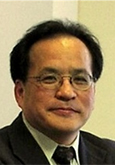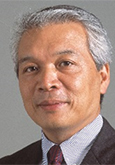近年の科学技術の発展によって、人と機械の協調・共創を通じたイノベーション、成長、繁栄の大きな機会が人間社会に訪れている。一方で、これまで経験しなかったような倫理、法律、社会、セキュリティ、プライバシーや安全に関わる課題も挙がっており、それらについては科学技術のもたらす便益を実現する前に考えておかなければならない。
このセッションでは、国内外の研究者を集め、情報技術を中心とした新たな科学技術がもたらす新しい社会の姿 (Society5.0、Reality 2.0、Cognitive Service Systemなど)、それらを実現する技術、さらに考慮すべき社会的な課題について、最新の事例や研究に基づいて議論し、今後の進め方を考えるきっかけにする。
| 企画提供者 | 科学技術振興機構 (JST)研究開発戦略センター(CRDS) |
|---|---|
| 開催日 | 11/6(日)12:30-15:00 |
| 会場 | D会場(東京都立産業技術研究センター)5階 講堂 |
| 形式 | シンポジウム |
| URL | https://www.jst.go.jp/crds/ |
| 備考 | 英語でのセッションとなります。※同時通訳なし |
【モデレーター】

Yassi Moghaddam (Executive Director: ISSIP(The International Society of Service Innovation Professionals))

James Spohrer (Director, Understanding Cognitive Systems: IBM)
【登壇者および発表概要】
James Spohrer (Director, Understanding Cognitive Systems: IBM)
“Cognition as a Service: An Industry Perspective”
This talk will provide an introduction to the cognitive era of computing, in which cognitive capabilities from natural language and video understanding, machine learning, and decision support with explanations and levels of confidence become broadly available as part of cognitive solutions in the cloud and on personal devices such as smartphones. This tutorial will cover what everyone needs to know about building, understanding, and working with cognitive systems in personal and professional lives - including the progression of cognitive systems from tools to assistants to collaborators to coaches to mediators, trusted to perform some interactions on behalf of the user. IBM transformation to a cognitive solutions and cloud platform company will also be discussed, including IBM Watson on Bluemix, as well as other industry trends.

Alexandra Medina-Borja(Program Director: NSF(National Science Foundation))
“The Future of Service Innovation: Partnerships fostering Human-Technology Teamwork”
The fundamental principle that engineered systems need to interact with and provide a clear benefit to humans is the “service” paradigm based on which the US National Science Foundation’s Partnerships for Innovation: Building Innovation Capacity (PFI:BIC) program created its focused solicitation in smart service systems. Human interaction with smart technologies and with physical and virtual realities can produce and deliver service(s) never before imagined in areas such as transportation, personalized health, precision agriculture, personalized education, etc.. These human-centered systems, involve stakeholders (e.g., users, recipients, beneficiaries, providers, and/or decision makers) utilizing the information and capability provided by the system with the potential to improve quality of life.
PFI:BIC has funded 34 highly interdisciplinary research teams in partnership with industry; these research partnerships test and integrate technologies that create services fostering increased human performance as opposed to replacing humans. Another area of great interest for the future are technologies that have the ability to adapt services to human variability, enabling true human-engineered system collaboration. In this model for service system innovation, the perspectives, competencies, and commitments of both academe and industry are needed to address the central issue of advancing and adapting technology in order to create or add value.

Minoru Etoh (Senior Vice President: NTT DoCoMo)
“Starting with how Japan can differentiate its AI-driven innovations from the others”
Japan Science and Technology Agency (JST) has launched a new research-funding program called “Development and Integration of Artificial Intelligence Technologies for Innovation Acceleration.” In this talk, the research supervisor explains the program policy on call for application, selection, and management of the research area. Here, the key discussion topic will be how Japan AI research community can bring unique research outcomes to the society and the industries. The uniqueness must have the value which demonstrate an understanding of the social issues to be resolved and the necessary fundamental technologies with a view to innovations.
In addition to the program introduction, this talk will cover also Japan’s possible innovation engines in comparison with Silicon Valley’s one which consists of market, talent and VC ecosystem.

Kazuo Iwano ( Principal Fellow:JST( Japan Science and Technology Agency))
“Reality 2.0 and Wisdom Computing – our vision toward the future”
Nowadays the boundary between physical and cyber existence are blurring, and thus an identity needs to be regarded as an inseparable fusion of physical and cyber existence. We now call this concept Reality 2.0. This affects identities of individual, community, enterprise, service, and society, and leads us to a new service platform realizing Software Defined Society. Our another vision called Wisdom Computing helps answer the following questions; With the ever-increasing progress of technology, we face problems of what values we realize in society, how we can be wiser, and how our society can be reach wiser decisions. We believe the above two concepts give us a base for drawing wise impacts of Information Technology to society.

David Nordfors(Co-founder : I4J(Innovation for Jobs))
“Innovation for Jobs - Disrupting Unemployment”
There is very much innovation that helps people spend better. There is not much innovation for helping people earn better. A sustainable innovation economy requires balancing the two. Most people today need better services for earning a living. The incumbent service, employment, is not managing to satisfy that need. Most of the 3 billion people who are working want a steady employment that earns their living. Only 1.3 billion have one. Out of them, only 200m are engaged in their job. There are double as many, 400m, who hater their job.
This is the workforce that creates $100T market value per year. How much market value would be created by 3B people, each one of them earning a living with a job that matches their skills, talents, passions, working in well-matched teams on meaningful tasks for clients they can communicate with? It would be many times higher. The untapped market for innovation for jobs is larger than $100T.
Sunil Narumalani (Program Director: NSF(National Science Foundation))
“ Future Research Directions: NSF Smart and Connected Communities.”
The U.S. National Science Foundation (NSF) has developed a multi-pronged strategy for investing in and advancing research in the area of smart cities, in alignment with the U.S. White House Smart Cities initiative. NSF’s investments pursue the fundamental understanding and basic research in frameworks that integrate and operate on data from multiple sources at multiple temporal and spatial scales; involve new sociotechnical systems that are interconnected and interdependent; and develop and test new technologies for innovative applications and services. Through engagement with community stakeholders, this strategy is intended to advance science and engineering foundations and build research capacity to improve understanding of local communities and advance discoveries and innovation that will ultimately enhance the quality of life within them. Furthermore, the strategy includes supporting and building international partnerships that leverage research strength and capacity in other parts of the world.

Daniel McDuff(Microsoft Research)
“How Artificial Emotion Intelligence Will Change Our Lives”
The wealth of digital devices around us has made it possible to create systems that can sense and respond to human emotions. Detecting facial expressions, voice tone, physiological responses and contextual information provides a rich picture of the emotional state of a user.
This will change how people interact with computers and presents the possibility of new applications that help improve our health and wellness. I will show examples of how everyday devices can sense emotional signals and discus how intelligent digital assistants might use this information. I will also highlight the social implications of this technology and how it might make us feel.

Norihiro Hagita ( Director: ATR Intelligent Robotics and Communication Laboratories )
“Intelligent Systems Creating Co-Experience Knowledge and Wisdom with Human-Machine Harmonious Collaboration”
This talk briefly introduces intelligent systems creating co-experience knowledge and wisdom with human-machine “harmonious” collaboration. The researches are supported by the Japan Science and Technology Agency (JST) as the CREST research project. The development includes the ethical, legal and social (ELS) challenges. That is, the systems are supposed to observe, recognize and structurize internal/external information of individual human and group activities while coping with ELS issues: the dignity, privacy, trust, liability, etc. These assume the cyber physical spaces and include services with human-robot interaction and collaboration, wearable sensors, cloud computing and the development of an open platform using the state-of-the-art technologies in appropriate areas such as brain and cognitive sciences, social sciences, natural language, and robotics.

Hideyuki Tokuda ( Professor :Faculty of Environment and Information Studies, Keio University)
“Evolution of IoT and it’s Social Impact”
Evolution of IoT is accelerating. Many new connected services and smart devices are created due to the penetration of various hard, soft, and social sensors, smart phones, wearable devices and actuators. IoT allows us to connect not only objects in physical space, but also creature, human, data and business processes. Because of IoT evolution, the convergence between cyber and physical space is also accelerating.
In this talk, we first discuss the problems in development of IoT services including security and privacy issues. We then address the future of IoT services and the social impact of innovative IoT solutions.